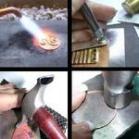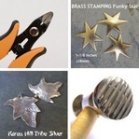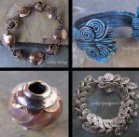patina before or after assembly?
by Kelly
(Michigan)
Hello, I've been on your site several times admiring your gorgeous creations! They are beautiful and unique! I was looking at your Urban Renewal necklace and had a question about finishes. When you state that you finished the piece with a patina finish, do you do it after you put the piece together? Does that not affect the beads as well? Or do you patina all the wire used first, then put the jewelry piece together? Thanks so much for you site, it is truly inspiring.
Kelly
Stacy's Answer:
Hi Kelly!
Thanks for the kudos! The Urban renewal necklace has a whole mess of wire in it! LOL Literally and figuratively. Because all the components used (Sterling silver with some brass and copper accents) could be tumbled, I fabricated the necklace first, tumbled for a few hours and then added a Liver-of-sulfur patina. I then removed the excess patina with a fine dark grey 3M scrubby pad and paid special attention to the little metal beads. The fine 3M scrubbies are artificial steel wool. I hate getting steel woolly fibers in my jewelry and in my fingers, so the finer 3M scrubbies are a great alternative and they last a long time. They are sometimes available in the paint department of Home Depot.
After removing the excess LOS, I then re-tumble for about 2 hours. THEN.....I polish using a Sunshine jewelry polishing cloth from Rio Grande. I have a large tumbler which allows me to tumble items that will not fit into a 3lb barrel. I also have a buffing machine, but never use it for wire jewelry. For a long time, I didn't tumble my wire jewelry at all. But I really like the finish tumbling gives and it's a huge time saver for me.
You can add a patina to the wire before putting a piece of jewelry together and that works OK if you're using items with components that cannot be put in the LOS solution or tumbled. But removing much of the excess crud that can accumulate on the metal can be laborious or darn near impossible. Another concern is that the more you handle wire, the more work-hardened it becomes. I try to stay away from components that cannot be tumbled or buffed on a wheel, etc. LOS can be applied by using a cotton swab, avoiding delicate areas.
As always, when in doubt, test! Put a few beads in the patina solution and in the tumbler and see what happens to them. That's a great way to know for sure how much trouble - or not - the piece may be to create.
















